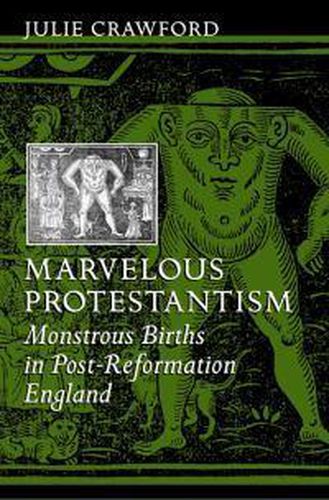Readings Newsletter
Become a Readings Member to make your shopping experience even easier.
Sign in or sign up for free!
You’re not far away from qualifying for FREE standard shipping within Australia
You’ve qualified for FREE standard shipping within Australia
The cart is loading…






In post-Reformation England, monster could mean both a horrible aberration and a divine embodiment or revelation. In Marvelous Protestantism , Julie Crawford examines accounts of monstrous births and the strikingly graphic illustrations accompanying them in popular pamphlets, demonstrating how Protestant reformers used these accounts to guide their public through the spiritual confusion and social turmoil of the time. Traditionally, accounts of monstrous births and other marvelous occurrences have been analyzed in relationship to the tabloid press or the rise of modern science. Crawford focuses instead on the ways in which broadsheets and pamphlets served a new religion desperately trying to establish clear guidelines for religious and moral behavior during a period of political uncertainty. Perceptively showing how monstrous births implicated women as reproductive forces, Crawford demonstrates how women were responsible for the reproduction of Protestantism itself, whether robust or grotesquely misconceived. Through its examination of the nature of propaganda and early modern reading practices, and of the central role women played in Protestant reform, Marvelous Protestantism establishes a new approach to interpreting post-Reformation English culture.
$9.00 standard shipping within Australia
FREE standard shipping within Australia for orders over $100.00
Express & International shipping calculated at checkout
In post-Reformation England, monster could mean both a horrible aberration and a divine embodiment or revelation. In Marvelous Protestantism , Julie Crawford examines accounts of monstrous births and the strikingly graphic illustrations accompanying them in popular pamphlets, demonstrating how Protestant reformers used these accounts to guide their public through the spiritual confusion and social turmoil of the time. Traditionally, accounts of monstrous births and other marvelous occurrences have been analyzed in relationship to the tabloid press or the rise of modern science. Crawford focuses instead on the ways in which broadsheets and pamphlets served a new religion desperately trying to establish clear guidelines for religious and moral behavior during a period of political uncertainty. Perceptively showing how monstrous births implicated women as reproductive forces, Crawford demonstrates how women were responsible for the reproduction of Protestantism itself, whether robust or grotesquely misconceived. Through its examination of the nature of propaganda and early modern reading practices, and of the central role women played in Protestant reform, Marvelous Protestantism establishes a new approach to interpreting post-Reformation English culture.